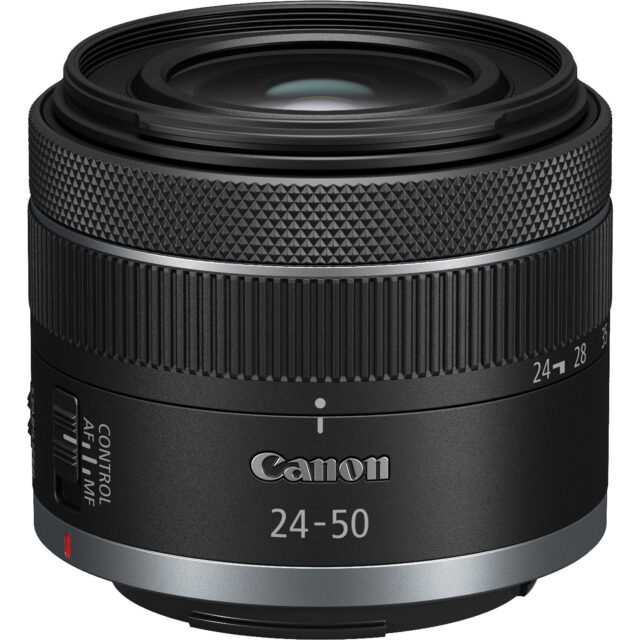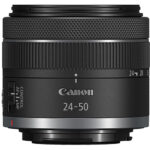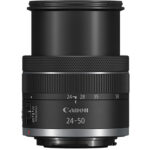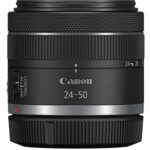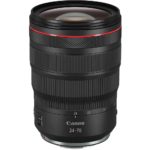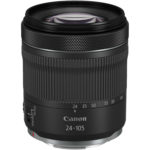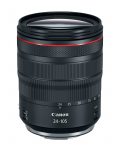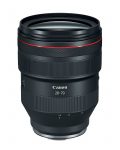Announced
Production status
Original name
System
Pros and cons
Genres or subjects of photography
Recommended slowest shutter speed when shooting static subjects handheld
Canon RF 24-50mm F/4.5-6.3 IS STM
Standard zoom lens • Digital era
Abbreviations
| RF | The lens is designed for Canon EOS R 35mm digital mirrorless cameras but can be also used on Canon EOS R APS-C digital mirrorless cameras. |
| IS | The lens is equipped with Image Stabilizer. |
| STM | The lens is equipped with Stepping Motor. |
Specification
| Optical design: | |
| 24mm - 50mm [2.1X zoom ratio] | |
| F/4.5 @ 24mm - F/6.3 @ 50mm | |
| 35mm full frame | |
| Canon RF | |
| 84° @ 24mm - 46.8° @ 50mm | |
| 8 elements in 8 groups | |
| 2 ASPH | |
| On Canon EOS R APS-C [1.61x] cameras: | |
35mm equivalent focal length range: | 38.6mm - 80.5mm (in terms of field of view) |
35mm equivalent speed range: | F/7.2 @ 24mm - F/10.1 @ 50mm (in terms of depth of field) |
Diagonal angle of view: | 58.5° @ 24mm - 30.1° @ 50mm |
| Diaphragm mechanism: | |
Diaphragm type: | Automatic |
Aperture control: | None; the aperture is controlled from the camera |
| 7 (seven) | |
| Zooming: | |
Zoom mechanism: | Manual |
Zoom control: | Zoom ring |
Zoom type: | Rotary |
Zooming method: | Extends while zooming |
Maximum aperture when zooming: | F/4.5 @ 24mm, F/5 @ 25mm, F/5.6 @ 32mm, F/6.3 @ 39mm |
| Focusing: | |
| 0.3m @ 24mm | |
| 0.35m @ 50mm | |
| 1:5.26 @ 50mm | |
Focusing modes: | Autofocus, manual focus |
Autofocus motor: | Stepping motor (Lead screw-type) |
Manual focus control: | Focusing ring |
Focus mode selector: | AF - MF |
Full-Time Manual Focus (FTM): | Determined by the camera |
| Image Stabilizer (IS): | |
| Yes | |
IS features: | Mode 1 |
| Panning Detection | |
| up to 4.5 stops @ 50mm | |
| Physical characteristics: | |
| 210g | |
| ⌀69.6×58mm | |
| - | |
| - | |
| Accessories: | |
| Screw-type 58mm | |
| EW-63C - Bayonet-type petal-shaped | |
| Not compatible |
Source of data
- Manufacturer's technical data.
Manufacturer description #1
RF24-50mm F4.5-6.3 IS STM wide-angle to standard zoom lens is a great entry point for full frame EOS R cameras. Great for still photography and videography, the RF24-50mm can provide intensity in your still images at 24mm, and excel with everyday shooting at 50mm. Rely on that wide field of view for vlogging, while still being able to zoom in when the need arises. The lightweight and compact nature of this lens pairs perfectly with the newer compact full-frame R-Series cameras. The RF24-50mm F4.5-6.3 IS STM also comes with built-in Optical Image Stabilization to further enhance your low-light shooting abilities by providing up to 4.5 stops* of shake correction, and up to 7.0 stops with coordinated IS. The RF24-50mm F4.5-6.3 IS STM also supports Movie Digital IS when connected to a camera with this feature. You will enjoy the versatility of this lens for all of your upcoming creative projects!
The RF24-50mm F4.5-6.3 IS STM makes for a lightweight and comfortable, all-day lens whether you are vlogging or shooting stills. It's ideal for capturing a variety of subjects without having to constantly change lenses.
Taking advantage of the Canon RF lens mount, the RF24-50mm F4.5-6.3 IS STM lens offers great optical quality, edge-to-edge. Its optical design includes two aspheric elements, and Canon Super Spectra Coating (SSC) to minimize ghosting and flare.
For consistently sharp results, the RF24-50mm F4.5-6.3 IS STM features built-in optical Image Stabilization, providing enhanced shake reduction for up to 4.5 stops* of shake correction. When paired with an EOS R-series camera that has In Body Image Stabilization (IBIS), the Coordinated IS allows for up to 7 stops of correction. This means more reliable handheld performance and clearer detail in low-light situations, without having to increase the ISO or decrease the shutter speed. Because of its enhanced stabilization, the RF24-50mm F4.5-6.3 IS STM can also help minimize the need for a tripod.
Canon's stepping motor (STM) technology is especially effective at producing smooth, quiet autofocus during video recording, even in low light. This lens is a perfect choice for multi-media content creation with quiet autofocus. And, STM focus drive provides responsive, quick - and exceptionally quiet - AF during still-image shooting, as well.
The RF24-50mm F4.5-6.3 IS STM lens incorporates a Focus/Control ring on the lens barrel that can directly adjust numerous settings including shutter speed, aperture, exposure compensation and more. Located towards the front of the lens and effectively adding a third dial to the EOS R camera's main dial and quick control dial. This Focus/Control ring can quickly be set to AF, MF, or Control thanks to the dedicated switch on the barrel of the lens.
The compact size and light weight of the lens makes it an ideal companion on long days and adventures. It is also handy for a day out shooting and when you want to be creative without having to carry multiple lenses.
Manufacturer description #2
The RF24-50mm f/4.5-6.3 IS STM was designed with priority on portability, providing a focal range of 24 to 50mm (wide angle to standard) to keep the lens compact and lightweight. It is the first such lens in Canon’s line-up with no EF-mount equivalent. With both the flexibility of a zoom and the portability of a typical standard prime lens, it promises to be an asset to users who desire compact, mobile setups, such as content creators shooting with a drone or gimbal.
The lens barrel of the RF24-50mm f/4.5-6.3 IS STM is designed to extend when shooting. It is at its longest at the 24mm wide-angle end, and retracts to a very compact 58mm for storage. This makes it fit easily not just into a small camera bag, but even a handbag or business bag, whether on its own or while attached to a camera body.
The RF24-50mm f/4.5-6.3 IS STM benefits from the large RF mount diameter and short back focus distance, which contribute to excellent image quality. It incorporates 2 aspherical lens elements that work together with digital distortion correction on the camera to correct the distortion aberrations that become more visible in the wide-angle range*. It also uses a 7-bladed circular aperture.
* Lens Aberration Correction on the camera will be automatically set to ‘ON’ when this lens is attached.
From the editor
In the early 1990s, Canon EOS series 35mm film SLR cameras were shipped with standard lenses of a 28-80/3.5-5.6 class. 30 (thirty) years of technical progress have passed, and the 24-50/4.5-6.3 IS STM is now a new standard lens for Canon EOS R series 35mm digital mirrorless cameras. In principle, we could stop there and write nothing further. However, being picky, let's try to compare the specifications of these lenses.
| EF 28-80/3.5-5.6 II USM | RF 24-50/4.5-6.3 IS STM | |
|---|---|---|
| Introduced: | 1993 | 2023 |
| Zoom ratio: | 2.9X | 2.1X |
| Optical design: | 9 elements - 9 groups, 2 ASPH | 8 elements - 8 groups, 2 ASPH |
| Closest focusing distance: | 0.38m across the focal range | 0.3m @ 24mm, 0.35m @ 50mm |
| Max. magnification: | 1:3.85 @ 80mm | 1:5.26 @ 50mm |
| AF motor: | Micro Ultrasonic | Stepping (Lead screw-type) |
| Full-Time Manual Focus: | - | + |
| Aperture blades: | 5 | 7 |
| Built-in IS: | - | up to 4.5 stops |
| Lens mount: | Plastic | Plastic |
| Weight: | 200g | 210g |
| Length: | 68.5mm (varies slightly with zooming) | 58mm @ 50mm, 87.4mm @ 24mm |
| Weather sealing: | - | - |
| Fluorine coating: | - | - |
| Filter size: | 58mm | 58mm |
With approximately the same weight, dimensions and the same filter size, the new lens is, of course, sharper, has a more advanced autofocus motor and a very effective optical image stabilizer, but was it worth it to reduce the range of focal lengths and speed like that?.. Moreover, aberrations are not fully corrected optically because the new lens relies on in-camera digital correction, especially in the wide-angle range.
And now let's compare this lens with the Panasonic LUMIX S 20-60mm F/3.5-5.6 designed for LEICA 35mm full-frame digital mirrorless cameras with the LEICA L mount:
| LUMIX S 20-60/3.5-5.6 | RF 24-50/4.5-6.3 IS STM | |
|---|---|---|
| Introduced: | 2020 | 2023 |
| Zoom ratio: | 3X | 2.1X |
| Optical design: | 11 elements - 9 groups, 2 ASPH, 3 ED, 1 UHR | 8 elements - 8 groups, 2 ASPH |
| Closest focusing distance: | 0.15m @ 20-26mm, 0.4m @ 60mm | 0.3m @ 24mm, 0.35m @ 50mm |
| Max. magnification: | 1:2.33 @ 26mm | 1:5.26 @ 50mm |
| AF motor: | Stepping | Stepping (Lead screw-type) |
| Full-Time Manual Focus: | + | + |
| Aperture blades: | 9 | 7 |
| Built-in IS: | - | up to 4.5 stops |
| Lens mount: | Metal | Plastic |
| Weight: | 350g | 210g |
| Length: | 87mm @ 20mm, 120mm @ 60mm | 58mm @ 50mm, 87.4mm @ 24mm |
| Weather sealing: | + | - |
| Fluorine coating: | + | - |
| Filter size: | 67mm | 58mm |
It can be seen with the naked eye that Panasonic's approach to the development of kit zoom lenses seems to be somewhat more successful. The Lumix S 20-60/3.5-5.6 offers a wider field of view and a short telephoto range while having slightly faster speed at both extremes of the focal length range. The lens mount is metal, but at 350g the lens is still one of the lightest kit zooms for 35mm full-frame digital mirrorless cameras. The lens is even weather sealed and features fluorine coating.
As with other short standard zooms, most shots with the RF 24-50/4.5-6.3 IS STM will be taken near the short end of the focal length range, otherwise there is no point in owning this lens, and the RF 50/1.8 STM will suffice instead. It's funny, however, that Canon thought otherwise, and the lens has the smallest size at focal length of 50mm, while at 24mm the extending part of the barrel increases the length of the lens by one and a half times. At focal length of 24mm, this lens is of the same size as the Lumix S 20-60/3.5-5.6 zoomed to 20mm. So even in terms of size, this Canon lens has no real advantage over Panasonic in the field.
Compared to other standard zoom lenses in the Canon EOS R system
- Narrowest focal length range (24-50mm)
- Slowest speed (F/4.5-6.3)
- Variable speed (F/4.5-6.3), along with the Canon RF 24-105/4-7.1 IS STM
- Lightest weight (210g)
- Shortest length (58mm)
- Not weather sealed, along with the Canon RF 24-105/4-7.1 IS STM
- Smallest filter size (58mm)
